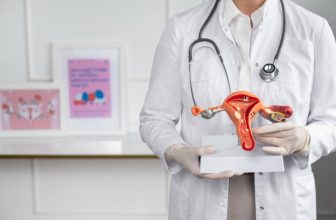Chicken Skin Discharge after Colposcopy

Chicken skin discharge might be an unexpected and unsettling occurrence after the procedure of colposcopy. It is understandable to have questions about the origins and effects of this kind of discharge following a colposcopy.
But why are you experiencing chicken skin discharge after colposcopy?
Well, it can happen due to the disturbance of cervical tissue during the process. Small blood clots or changes in the tissue’s texture could be the cause of the discharge’s look of chicken skin. In post colposcopy phrase body can shed dead or damaged tissue. These dead skins can come in the form of chicken skin-like discharge.
Chicken Skin Discharge after Colposcopy
A colposcopy is a process used to inspect the cervix, vagina, and vulva to check for any cancerous alterations. The colposcopist will introduce a tool called a speculum into your vagina and gently open it to inspect your cervix. Your cervix will be examined using a microscope (colposcope) with a powerful light. The colposcope stays outside of your body and does not penetrate the vagina.
It is typical to see changes in cervical discharge or mucus after a colposcopy. This is because the process disturbs the cervical tissue. This may increase production of cervical mucus or alter it’s natural composition.
Depending on the individual, the discharge may have a different texture and appearance. Because it is thicker or clumpier, some people might say it resembles “chicken skin.” It might be a clear, yellowish, or white discharge. These alterations are often transient and should stop within a few days to a week.
These changes can be attributable to several things, such as:
Damage to Cervical Tissue:
The colposcopy process uses tools and requires biopsies that have the potential to damage cervical tissue. The cervical mucus may undergo brief modifications, as a result, changing in color or texture.
Increased Mucus Production:
The colposcopy process might cause irritation or inflammation, which can cause the cervical glands to secrete more mucus than usual. The volume of discharge may fluctuate as a result of this enhanced output.
Discharge During Healing Process:
Cellular repair and regeneration are a part of the body’s natural healing process following any tissue manipulation or biopsy. The consistency of the discharge may alter as the cervix heals.
How Long Will Chicken Skin Discharge Last after Colposcopy?
In general, post-colposcopy discharge should progressively return to normal over a few days to a week. In some cases, it can last up to 3 weeks. The complexity of the surgery, the rate of recovery, and the patient’s general condition might affect how long it takes.
The discharge may have a foul odor. Other alarming symptoms can be intense pain, extensive bleeding, or fever. In such cases, the discharge can last long. You can contact a doctor if you experience these symptoms. They can assess your particular scenario and offer suitable advice based on your unique circumstances.
Is Smelly Discharge after Colposcopy normal?
Along with chicken skin discharge after colposcopy, you may notice smell. It is typical to notice variations in the consistency, color, and odor of vaginal discharge following a colposcopy. These changes are often expected and are a result of healing.
Small tissue fragments or other debris may occasionally stay in the cervix after colposcopy surgery. This can lead to infection and foul discharge.
A transient stench can be an indication of healing. On the other hand, a persistent strong odor can be pointing to an infection. It’s crucial to distinguish between these two types of symptoms.
Certain odor and discharge changes are to be anticipated following a colposcopy. it’s critical to get medical help immediately if you develop any other symptoms, including itching, burning, pelvic discomfort, or unusual bleeding.
Signs of Infection after Colposcopy
Colposcopy is often risk-free. However, there is a little possibility of being sick afterwards. After a colposcopy, it’s critical to recognize infection symptoms so that quick medical assistance may be sought. Possible symptoms of infection following a colposcopy include:
Stench-Filled Discharge:
An infection may be indicated by a strange or overpowering smell emanating from the vaginal discharge. This may be a symptom of bacterial vaginosis, a typical vaginal infection, or another illness.
Irregular Or Increased Discharge:
After a colposcopy, certain variations in discharge are normal. However, if the discharge increases or becomes too thick, clumpy, yellowish, or greenish, it might indicate an infection.
Persistent Pain:
After a colposcopy, mild cramping and pain are typical. But if the pain worsens it can be a sign of an infection.
Pelvic Discomfort:
Pelvic discomfort or soreness may be brought on by infection or inflammation. You may need to see a doctor if the discomfort continues.
Fever:
Chills and a fever, which is commonly defined as a body temperature over 100.4°F (38°C), are signs of infection. If you experience high and persistent fever after colposcopy, that means you may have infection.
Unusual Bleeding:
While little bleeding or spotting is common following a colposcopy. Severe random bleeding or the presence of bright red blood clots might indicate an infection or another problem.
Post-Colposcopy Care
It’s vital to look for oneself after a colposcopy to encourage recovery and lower the chance of problems. Following are some general guidelines:
- After the surgery, give yourself time to relax and recover. For at least 24 to 48 hours, refrain from strenuous activity, heavy lifting, and vigorous exercise.
- For the period specified by your doctor, refrain from douching, tampon usage, and sexual activity. This period is generally between one and two weeks long because the cervix needs time to heal correctly.
- Improve your personal hygiene to lower your chance of contracting an infection. To clean the external genital region, use warm water and mild, unscented soaps.
- For the duration of the suggested time period outlined by your healthcare physician, refrain from bathing in open water.
- After the colposcopy, over-the-counter pain medicines like acetaminophen or ibuprofen may be helpful if you suffer discomfort or light cramping. Always adhere to the dosing guidelines and speak with your doctor if you have any questions.
- Watch out for any infection-related symptoms, such as a bad smell, increased or unusual discharge, ongoing discomfort, fever, or excessive bleeding.
Conclusion:
If you get chicken skin discharge after colposcopy, observe your condition for the next few days. Though this condition is considered to be part of the after-effect of colposcopy, be careful about the infection symptoms. Don’t forget to show up at all planned follow-up visits. These meetings are crucial for tracking your development and reviewing the colposcopy’s findings.
Do not hesitate to contact your healthcare professional with any queries, worries, or ambiguities concerning your recovery. Clear communication ensures you get the right advice and assistance during your recovery journey.





